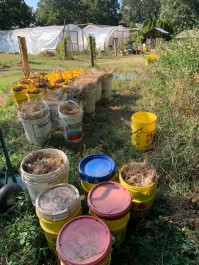Banana leaves! Bamboo! Steeped tea leaves!
When I'm not prepping rows or planting fall crops, I find myself spending a lot of time thinking about decomposition. Specifically, the ingredients I can find locally to create diverse compost piles which then lead to soil with a diversity of microorganisms.
When it comes to saving this planet, the key isn't going to be scientific breakthroughs or geoengineering techniques. It'll be diversity - the diversity of organisms thriving below the soil's surface and the diversity of plants and animals thriving on top.
Soil has the ability to sequester all the carbon we emit and then some. When scientists rank places we can stash the extra carbon we've carelessly thrown into the atmosphere, soil is far and away in the top spot, followed by oceans and trees.
The problem is that most of what is beneath our feet is dirt. What's the difference? Dirt is dead, soil is alive.
I've looked at many of Atlanta's agricultural soils under a microscope. There's not much to them. A smattering of organic matter, a handful of bacteria. Thriving soils are a pulsing jungle gym of life - fungi sending mycelium across the view, amoebas oozing along, nematodes undulating past, flagellates bumbling and ciliates zooming through clouds of bacteria.
My goal is to create compost using local ingredients that is pulsing with that life. To make it consistently, through all seasons. And then to use that compost to seed that life into my dirt, so that the plants can work with all the organisms to get the nutrients they need.
So I spend my days pulling weeds and pondering banana leaves and whether their waxy surfaces will delay decomposition for enough time to allow the leaves to power decomposition through the middle stages of a pile. I wonder at the carbon to nitrogen ratios of various growth stages of bamboo, and consider whether a consumer level wood chipper could handle grinding the poles into small pieces so as to increase surface area for microbes to go to work.
I hope to come out of this winter having made 100 piles, and go into spring using those piles to seed life into my soils.


